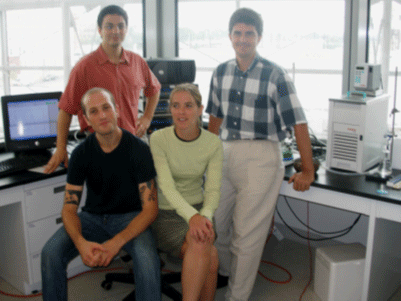Supercapacitors Start a Revolution in Energy Storage Devices
When shopping for power sources to make Palm Pilots, iPods, and other ubiquitous personal electronic devices work, a capacitor is probably the last thing on most consumers?, even educated consumers?, minds. Supercapacitors, having the ability to store upwards of 1,000,000 times more energy per unit mass than traditional power sources and having a power density 10-100x higher than batteries, may begin popping up on the public?s radar as a viable option in the near future. Work published by J. Chmiola, et al. in the September 22nd issue of Science magazine [1] provides the roadmap to give supercapacitors an even greater energy boost.
What is a supercapacitor and how does it compare to a battery?
Supercapacitors look much like batteries from a distance, but, upon closer inspection, are quite different in internal construction and function. Unlike batteries that store electrical energy in chemical bonds, supercapacitors store energy electrostatically between a solid electrode and oppositely charged electrolyte ions that migrate towards the electrode when a potential is applied. This charged surface is analogous to the “capacitor” created between a child’s hair and a charged balloon held above.
In supercapacitors, carbon is typically the electrode of choice because it is chemically inert, electrically conductive, and can easily be processed to contain a huge amount of internal pores. The pore walls of these internal pores have an enormous total surface area that allows for a tremendous amount of energy to be “fit” into the supercapacitor, virtually comparable to stuffing a football field into the volume of a pea. Because the charge stored on this massive surface is not subject to the same thermodynamics as battery oxidation-reduction reactions, quick charging and discharging with minimal losses is achievable. This also causes supercapacitors to outperform batteries at low-temperature extremes and have practically an unlimited number of charge-discharge cycles. This is not the case for short-life lithium batteries that currently appear in cell phones and laptop computers.
Small and Mighty
Researchers have been working to make the smallest storage devices with the largest storage capacity. To make supercapacitors a viable energy storage candidate in applications where size is paramount, such as for mobile devices, personal electronic devices, and specialized military applications, significant work has gone into optimizing the electrode materials to deliver maximum capacitance per unit mass (so called, specific capacitance). This has led scientists to explore the carbon pore sizes of a wide variety of materials, such as coconut shells, phenolic resins, rice husk, and coal, as possible options for use in these storage devices. These materials are subsequently carbonized and oxidized (activated) at moderate temperatures to produce porous activated carbon. Other avenues of research are directed at pursuing carbon nanotubes. All of these research avenues are geared towards finding a carbon with a pore structure precisely optimized for supercapacitors. This can be appreciated by considering that decreasing the size of these pores has the direct effect of increasing the surface area, leading to more area available for ion adsorption.
Researchers have long thought that, though continuously decreasing the pore size increases the surface area, solvent molecules specifically associated with each electrolyte ion would limit the accessible pore size. Historically, scientists have put a cap of 1 nanometer on the minimum accessible pore size – any pores smaller than this were thought to be blocked. Without processing methods to make carbon materials with pores exclusively tailored to be smaller than 1 nanometer, this theory could not be tested. The quest for carbon materials with the largest fraction of the largest pores remained the popular motto.

Figure: Paper authors in the Nanomaterials Laboratory at Drexel University (from left to right): sitting - John Chmiola and Dr. Christelle Portet, standing – Dr. Gleb Yushin and Prof. Yury Gogotsi
The Solution
Using titanium carbide as a template and selectively extracting the titanium atoms, the research group of Professor Yury Gogotsi at Drexel University, U.S.A., synthesized a carbon material with uniform pores tuned to be from 0.6 to 2.3 nanometers across. Following the presumption that “small pores are bad,” the samples with the smallest pores were expected to have negligible performance. In a bit of scientific serendipity, what was originally thought to be the worst case scenario became the best case scenario in the tests conducted at Paul Sabatier University, France, by the group of Professor Patrice Simon. A near 50% improvement in energy density over other supercapacitor carbons was achieved by venturing into a pore size realm previously thought to hold no value. These miniature pores, which are barely large enough to accommodate the electrolyte ions, likely cause the ion’s solvent sheath to become distorted, or altogether removed. In any case, the closer approach of ion center to pore wall forced by the pore geometry is shown to be the likely candidate for this anomalous increase in capacitance.
The Market for Supercapacitors
The largest share of the $1.6 billion (U.S. market figures) market for supercapacitors is currently uninterruptible power supplies (UPS) and power quality applications. Frost and Sullivan estimates that the total UPS market will reach $7 billion by 2008. Since 80% of power line disturbances last less than a second, supercapacitors can provide a better solution than batteries because they offer the lowest cost per unit power and have the longest operational life. Another quickly growing market is hybrid electric vehicles (HEV). Over 30 HEV models are expected to be on the road by 2009, an astounding 300% growth rate that is expected to last at least a half-decade, according to JD Power and Associates. HEV sales, currently a modest 200,000 in the U.S., is expected to quadruple by the beginning of the next decade, with demand exceeding supply in most markets. With nearly every automaker actively pursuing supercapacitor research or having partnerships with existing supercapacitor companies, there is a clear indication of their intention to begin incorporating supercapacitors in their HEV lines.
Supercapacitors clearly have many important applications. The research of Dr. Gogotsi’s group may lead to new supercapacitors with improved energy and power characteristics that may replace or supplement batteries in a variety of applications.
[1] Chmiola, J., Yushin, G., Gogotsi, Y., Portet, C., Simon, P., & Taberna, P. L. Science, 313, 1760-1763 (2006). Read the article.






 Read more
Read more
The article should be of considerable interest in view of the excellent work of the authors and because supercapacitors are a hot subject of highest technical importance. I recommend publication on the Scitizen pages.
The content of the article is of great interest. Some of the text needs a better formulation.
- ' Supercapacitors look like batteries from a distance ..'
- ' .. and a charged ballon held above.'
- ' virtually comparabme to stuffing a football field into valume of a pea'
- ' the largest pores remained the popular motto'
The article could also be shortened. The last section about the market needs some caution and needs to be shorter. There is certainly a large potential to make it to the market but there is a long way from the first laboratory observation to make a real product.
Granted, you're not the only site reporting this news with inadequate numbers. But you could improve the situation with a bit of research that would be easy for you, but hard for many of your readers.
Thanks,
Chris
[Response] When comparing the performance of the supercapacitors presented in the Science article with other power sources, the 1,000,000x factor was for dielectric capacitors and unfortunately the text reflects a much broader base of power source technologies. This article meant to serve as a non-technical introduction to the work presented in Science. All technical details were left in the article. For the interest of the readers, though, maximum energy density of the carbon material presented is in excess of 100 W-h/kg. Taking into account packaging and electrolyte, a conservative estimate for device energy density is 25 W-h/kg. These energy numbers, though lower than most batteries, serve to show that supercapacitor performance is creeping into the range where they may begin seeing applications currently restricted to only batteries.
*very* quickly compared to batteries--sounds like a useful product.
Thanks,
Mati Arulepp, http://www.skeletonnanolab.com